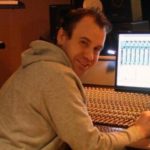Academy Dashboard › Forum › Studio › Studio Building / Acoustics › Hearing Compensation for Elderly People
Tagged: hearing loss
- This topic has 5 replies, 3 voices, and was last updated 4 years ago by
 Magnus Emilsson.
Magnus Emilsson.
-
AuthorPosts
-
March 29, 2020 at 4:22 am #72980
 Guido tum SudenKeymaster
Guido tum SudenKeymasterHi everyone,
I had this idea, although I'm pretty sure I'm not the first one. Let me know what you think.
This is about hearing compensation, mainly about differences between the left and right ear. It's not about room treatment with software or an overall treatment like using a Tilt EQ to compensate for the loss of higher frequencies. Most of that, we are doing by getting used to the sound of our speakers.
But in a case like mine, it happens that you have difficulties getting sounds with equal loudness to the left and right channel, while the meters show something different. Or you hear a certain mono sound which doesn't seem to come from the middle.Here is what I did:
– Put on your best headphones (in my case DT 880 Pro).
– Use a sinus test oscillator of your DAW and set it to 20 Hz at 0 dB.
– Turn up the volume of your controller until you hear (it's more a feeling) the tone.
– Now go through all the bands of a 31 Band EQ, left and right ear separately, and turn up the volume in the test oscillator plugin (not the controller) until you hear the tone.
– Note the value you set as a positive number in two rows of a spreadsheet (if you dialled in -52 dB to hear the tone, write down 52.
– Set two more rows for the goal of the left and right ear. These numbers should be the same, an average of Left and Right. If numbers deviate too much you can smooth the curve.
– Now calculate your goal number minus the original numbers and you will get two more rows which indicate how to set the Equalizer.
– Take an Grafic EQ with 31 bands (I used EQuivocate) and set the numbers accordingly.
– You can get a graph from the spreadsheet.Here is my graph. The first two rows are the volumes I had to set in the plugin.
I set the next two rows to the numbers I wanted.
The final two rows show what to set in the Graphic EQ.https://www.dropbox.com/s/j3wbd1xc1v3ef2l/Hearing-Compensation.png?dl=0
Blue is the left ear, Green the right, Orange is the goal.If you use a daw like Logic Pro X you need to set the plugin to Dual-Mono. If you an EQ like Pro-Q3 you can set the left and right channel independently, but don't set the Q too low or too high.
Big difference when I heard it the first time especially with hard panned distorted guitars because of the huge differences between my two ears at 4k, 5k and 8k.
So, what do you think? Is this a good idea? Will big changes in the EQ change the sound too much? Should it only be the average of left and right because smoothing the curve won't be necessary because it's part of the way you hear …
Guido
-
This topic was modified 4 years ago by
 Guido tum Suden.
Guido tum Suden.
March 29, 2020 at 3:13 pm #73051 KevinParticipant
KevinParticipantI can't say if it is a good idea or not. If it works for you, Guido, then it probably is a good idea. I think it would be better to learn to live/work with the hearing loss which is perfectly possible. I'm not an audiologist so the information I going to write here probably isn't complete.
You mentioned that your experiment is not about hearing loss, but about a general difference in volume that you experience in one ear. As far as I know, the latter is a consequence of the former.
Anyway, because you mentioned that you have hearing loss at one side, I expect you have damaged tiny hair cells that are inside your inner hearing organ (cochlea) because of an experience of noise exposure in your life rather than aging. If these hair cells are damaged, it's irreversible and you simply don't hear a specific frequency or in your case a whole range of frequencies anymore.
What you are doing by applying an EQ on one side of your speakers, you stimulate the hair cells that are closest to the damaged hair cells and also the second harmonics of that frequency. That gives you a false idea of what you think you hear and what actually comes out of your speakers. It's simply impossible that suddenly that row of damaged hair cells are stimulated again.
Another thing why I think this isn't a good idea is because you still have another ear with no damaged hair cells. If you change the EQ of one side of your speaker system, it's not so that your opposite ear doesn't hear this. So, by applying EQ, even on one speaker, leads you into a completely false perception of the sound in both of your ears.
I know that you think that I don't understand your post very well or haven't read it carefully. Believe me, I did read it more than once : ). What you want to do is changing the EQ in both of your speakers to achieve the "goal curve". Well, the same story as above is applicable here. There is an error that happens in your hearing system. Your speaker system is OK. Introducing an error in your speaker system to compensate for the error in your hearing system will lead you further from the truth rather than closer.
Just my thoughts.
KevinMarch 30, 2020 at 11:54 pm #73132 Guido tum SudenKeymaster
Guido tum SudenKeymasterHi Kevin,
Thanks for the answer.
I did know the things you wrote but I didn't think about them in this context, so thanks for reminding me.This makes things more complicated. 🙂
I know, that it's best to get used to how the system sounds, but my problem here is the more than 10 dB difference at 4k.
4k is a very important frequency.
How would I be able to get two hard panned similar instruments to the same loudness?
For highs above 10k I use an analyzer to not dial in too much. I can't do that at 4k.
Another example: A duet with a male and female singer. Since one of them will be much more present at 4k, I will not be able to get them on the same level.
Mixing in mono might help.Ideas, thoughts?
Guido
March 31, 2020 at 9:08 am #73162 Magnus EmilssonParticipant
Magnus EmilssonParticipantHello Guido.
I too suffer from a rather severe dip of 10db between about 600hz to about 3khz on my right ear. Making it even harder to manage is the fact that it is variable both in frequency and level. My hearing loss is due to a chronic inflammation (auto immune reaction) of the auditory vestibular nerve. So depending on things like stress, viruses and the general alertness of my immune system the hearing loss varies wildly. So any eq compensation is out of the question for me anyhow.
I have found that moving my head about a bit and turning it from side to side allows me to balance things in spite of this problem. When using headphones I need to remember to check the other side from time to time by wearing them the wrong way around.
I also cheat using the Pure Analyzer Essential when in doubt, it has a very useful frequency/balance/phase display, where you can see the relative energy for L/R through the freq. spectrum./Magnus
March 31, 2020 at 12:02 pm #73172 KevinParticipant
KevinParticipantMixing in mono will probably be the way that works the best for you, indeed. With mono, I don't mean to collapse your stereo mix to a dual-mono system. I mean literally mixing on ONE speaker. Also, let someone else balance the vocals and listen to it in stereo and mono and memorize that. Make a mixdown of it so you always have a reference at hand. I know it sounds stupid, but what you have is seen in general as a handicap, but it's a real problem in this sector. I don't have to explain that. That being said, it shouldn't stop you from making music and, again, learn to do your work with your handicap probably is the best way to do it rather than inserting all kinds of tricks between that what you send to the master and that what comes out of your speakers, which always gives me shivers regardless the reason.
April 1, 2020 at 9:51 am #73205 Magnus EmilssonParticipant
Magnus EmilssonParticipantI'm thinking a setup similar to what Dave Pensado has will also work well as a sort of pseudo mono. He has a pair of Auratones/Mixcubes really close together right in front of him on the desk that he uses to check stuff on.
-
This topic was modified 4 years ago by
-
AuthorPosts
- You must be logged in to reply to this topic.

